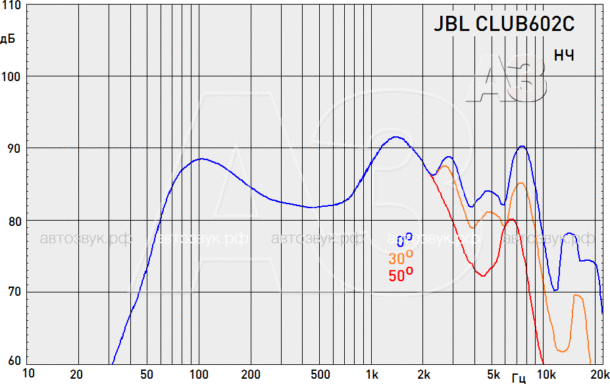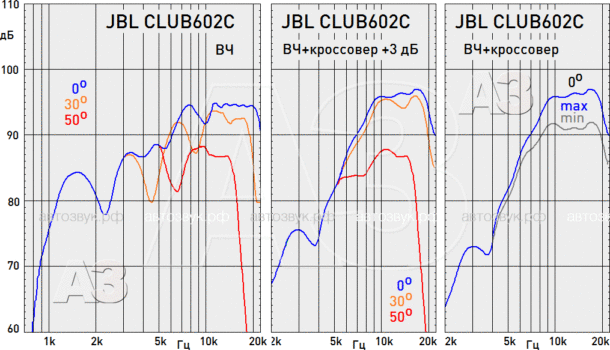ЛИЧНЫЙ ОПЫТ
В положении тестовых боксов «по домашнему» тональный баланс конкретно «хард-роковый» с выделенными низкими и высокими частотами, даже при «нулевом» положении аттенюатора. При «автомобильном» положении акустики (мидбас – боком, твитер – «в лоб») верхняя середина пригладилась, звучание стало более сбалансированным. Середина диапазона достаточно детальная, «панчевый» средний бас воспроизводится упруго и рельефно. Нижний бас заметно упрощён, что для акустики такого калибра вполне ожидаемо. Общий звуковой почерк довольно ровный и слитный, акустика звучит корректно и детально.
С учётом высокой отдачи и слабо выраженной направленности пищалки можно направлять в середину салона. Как обычно, полезно испробовать разные варианты относительной полярности динамиков и уровня, желательно – с контролем АЧХ в точке прослушивания.
Summary
The LSR 305’s are by all accounts an entry-level studio monitor meant to satisfy the needs of the producer/engineer looking for exceptional, reference-level sound quality.
They are active, meaning they don’t need a separate amp to power. They do however need AC (alternating current) power. AC simply means the power frequently reverses direction many times per second. The standard is 60Hz, with hertz being your typical unit of measure. Do you want a hertz doughnut?
Basically, just plug these bad boys into the outlet from your JBL’s and shut up. Just kidding These monitors come with two cables, as each needs its own power source. Basically, they are MONO speakers and need 2 separate cables running from the back into whatever you are using to receive and transmit the signal.
Some common sources and DAC’s (Digital to Analog interfaces/mixers) that are used with the JBL’s:
An audio interface. I personally have the Scarlett 2i2. What does an audio interface do? It’s a beast of a unit and powers my JBLs magnificently. It uses 2 balanced TRS line output jacks and goes really well with the combo balanced TRS to XLR cables. You could also go with the Scarlett solo, which has unbalanced RCA outputs rather than balanced TRS. TRS vs. TS.
Update: The Scarlett Solo 3rd Generation has balanced TRS Outputs and is cheaper than a 2i2 if you only need one input on the front.
A mixer. An entry-level option would be the Behringer Xenyx 802. Gets pretty nice reviews!
I will outline some different connections in the “What you will need” section below.
What you will need?
Chillin’ in-studio This is the 1st generation model. They have since come out with a 3rd!
You will need some sort of receiver, interface, or mixer (as mentioned above), acting as a mediator/middle man of sorts, to transmit signals between the computer and the speakers.
Since 2014 I have used the Scarlett 2i2 (pictured above), and it has worked flawlessly.
Check out this in-depth explanation of Bit depth vs. sample rate. It goes into some of the logistics behind digital to analog, explaining specifically why you need an interface to communicate with your computer!
As for cables
You may not necessarily need all of these cables. This is just to kind of get you started and show that there are a lot of ways to connect speakers to an interface or mixer!
Some different options (either/or):
For the Scarlett Solo
dual 1/4 in. TS to dual RCA (the standard option)
Scarlett Solo (3rd Generation)
Balanced TRS to XLR (my preferred option)
For the Scarlett 2i2
- 2 balanced TRS to XLR cables (my preferred option)
- 2 balanced TRS to TRS cables
For the Behringer UCA 202
dual 1/4 in. TS to dual RCA
For a typical mixer
XLR female to dual XLR male
For your iPad
3.5 mm TRS to Dual XLR
For your home audio receiver
Your receiver basically takes the audio in from your CD player, turntable, etc., and releases it out again, amplifying the sound out of the JBLs. (not unlike the other setups). If you plan to use these in a home theater setup, you will need to check the manual (or the back) of your receiver to see which audio-out cable you will need. A common one would be:
dual 1/4 in. TS to dual RCA. The RCA cables would run from your receiver to each of the monitors. You would use the RCA outs on your receiver, as they are meant to send a signal to another device (in this case the monitors).
Placement
They are near-field monitors, meaning that they sound best when you’re near them! Sounds obvious, but the farther you are away, the less impact the sound has. This is especially true for the higher frequencies that lose a bit of energy at a greater distance. That said, you want them both facing diagonal towards you, creating a 3 point equilateral triangle.
They will also sound much better at ear level. This means you should invest in some stands (if space allows), build 2 simple shelving units on the wall, or MacGyver something to get them elevated to around ear level. All of this really depends on your studio space. For me right now, they sit on my desk in a triangle formation and still sound great. I’m currently looking into elevating them though for improved clarity.
Acoustics
Being that the bass is ported on the rear, you may want to consider some Acoustic Sound Treatment in the form of a couple of acoustic foam panels. It’s impossible to get a perfect sound in a bedroom, but taking this extra step will help the sound coming out of the JBL’s immensely. If you plan on having these sitting on your desk, some panels will go a long way in improving the overall sound coming out of them.
Rear ported.
That said, I actually do not have any treatment and still love the sound of the monitors. If you can’t invest in panels at the moment, just make sure to place them far enough away from the wall.
ИЗМЕРЕНИЯ
Мощность акустики изготовитель заявляет как 70 Вт RMS и 210 Вт пиковой мощности при чувствительности 92 дБ (2,83 В). Поскольку импеданс акустики 3 Ом, то при этом напряжении развивается мощность 2,7 Вт. Приводя к стандартному 1 Вт, получаем 88 дБ. Полосу воспроизводимых частот заявили серьёзную: 55 Гц – 20 кГц. Остальные параметры предстоит измерить.
| Параметры Тиля-Смолла | НЧ (заявка) | НЧ (факт) | ВЧ (факт) |
|---|---|---|---|
| FS, Гц | 82,7 | 80,5 | 2017,7 |
| VAS, л | 6,4107 | 7,82 | — |
| Re, Ом | 2,37 | 2,3 | 2,7 |
| QTS | 1,194 | 0,937 | 1,097 |
| QMS | 10,965 | 7,15 | 1,42 |
| QES | 1,34 | 1,08 | 4,79 |
| B×l, T*m | 3,635 | 4,07 | — |
| dBSPL | 88 | 87,8 | — |
| MMS, г | 14,409 | 13,07 | — |
Попадания в заявку довольно точные – а некоторые параметры оказались даже лучше (в частности, добротность). Рассмотрим импеданс компонентов.

Компоненты низкоомные. Малозаметный резонансный пик указывает на основательное феррожидкостное демпфирование высокочастотника
Теперь займёмся акустическими измерениями.

Картина для калибра 6 дюймов типичная: на низких частотах кривая идёт прогнозируемо гладко и плавно, но выше 2 кГц направленность становится заметной, внеосевая отдача резко падает и начинается болтанка, результат интерференции волн от разных участков диффузора. Обычная картина для конических диффузоров…

Направленность пищалки незначительная, проявляется в снижении уровня и повышении неравномерности АЧХ, но крутого спада нет, и аттенюатор сможет с этим справиться. Влияние аттенюатора на осевую АЧХ – порядка 5 дБ
Снимать АЧХ комплекта особого смысла нет – результат на стенде не будет иметь ничего общего с реальностью. С учётом реального расположения динамиков в салоне, углов и расстояний полезно проверить оба варианта полярности подключения пищалки.
Ну и, наконец, про искажения, они совсем невысокие. Искажения измерены в характерных частотных полосах при звуковом давлении 90 дБ (1 м).
| 100 — 300 Гц | 1,2% |
| 300 — 1000 Гц | 0,92% |
| 1 — 3 кГц | 0,39% |
| 3 — 10 кГц | 0,11% |
Cons
- No protective grills on the woofer.
- Bass is ported on the back, which may present problems if your monitors are up near a wall or corner of the room. If this is the case, you should invest in some acoustic foam (mentioned earlier).
- Tweeter material seems fragile. I did gently touch my finger on it and can confirm this. Just be extra careful I suppose. I haven’t had an issue with them, however.
- Some say they are too bulky and look ugly. While I can see the bulky complaint, they aren’t ugly in my opinion. They are kind of big, however, so be aware if you are really strapped for space.
Connections on the back.
Introduction
Like you, I needed a good mixing/reference solution and waited quite a long time before deciding to purchase any kind of monitors! What are studio monitors?
I don’t really know why. Perhaps I was intimidated by all the technical jargon that goes along with higher-end audio equipment. For the longest time, I used my computer’s internal Soundcard (whichever laptop I was using at the time), and my mixes suffered. What is a Soundcard? It wasn’t until I purchased the Sony MDR 7506’s that my beat quality improved tenfold.
Check out some of my Beats!
However, it is common knowledge that you shouldn’t rely on headphones alone to mix. With that in mind, my next task was figuring out which monitors got the best reviews, packed a hefty punch, remained flat enough to mix on, and was also easy on the wallet.
I scoured the internet and read as much as I could. I read every single amazon review, then went to as many other sites as possible. I literally went back and forth for weeks before finally arriving at a decision. I had never heard of the name JBL before, so I put extra care into making sure there was a universal consensus about how good these are.
To put it bluntly, the hype was real.
It’s almost like buying your first smartphone. You can never go back to a flip phone or even a slide phone for that matter. The convenience of a smartphone is priceless in today’s fast-paced society. Likewise, I could never go back to laptop speakers, standard computer speakers, or even a pair of Logitechs! The difference in sound quality is night and day.
They are everything I wanted and needed, and then some. Are these the best ever? No, of course not. Are they the best entry-level monitors? I would say so.
Lego men bask in the 305’s glory.





![Jbl lsr 305 studio monitor review [definitive guide] - home studio basics](http://basis-tp.ru/wp-content/uploads/3/0/a/30a7db1d635d5ba1c896d30fea28eadc.jpeg)


![Jbl lsr 305 studio monitor review [definitive guide]](http://basis-tp.ru/wp-content/uploads/2/8/c/28c7940e474a748bc13c7706c3d526b1.jpeg)



![Jbl lsr 305 studio monitor review [definitive guide] - home studio basics](http://basis-tp.ru/wp-content/uploads/7/e/9/7e900cae5a94d6116d370ccff90a84d7.jpeg)


![Jbl lsr 305 studio monitor review [definitive guide]](http://basis-tp.ru/wp-content/uploads/d/8/5/d85b57ba69ca362ad0b4b6a4461cec68.jpeg)



![Jbl lsr 305 studio monitor review [definitive guide] - home studio basics](http://basis-tp.ru/wp-content/uploads/6/c/b/6cbdae6b072d54a49219bf8f6e09732f.jpeg)


![Jbl lsr 305 studio monitor review [definitive guide]](http://basis-tp.ru/wp-content/uploads/f/9/c/f9ca5043502dcde9f0c0268c5b75fc40.jpeg)


![Jbl lsr 305 studio monitor review [definitive guide] - home studio basics](http://basis-tp.ru/wp-content/uploads/e/4/1/e418ec2007f576211a419938b7187e2e.jpeg)


![Jbl lsr 305 studio monitor review [definitive guide]](http://basis-tp.ru/wp-content/uploads/5/6/2/562f866b85d92fe642cbefed1d6236eb.jpeg)

